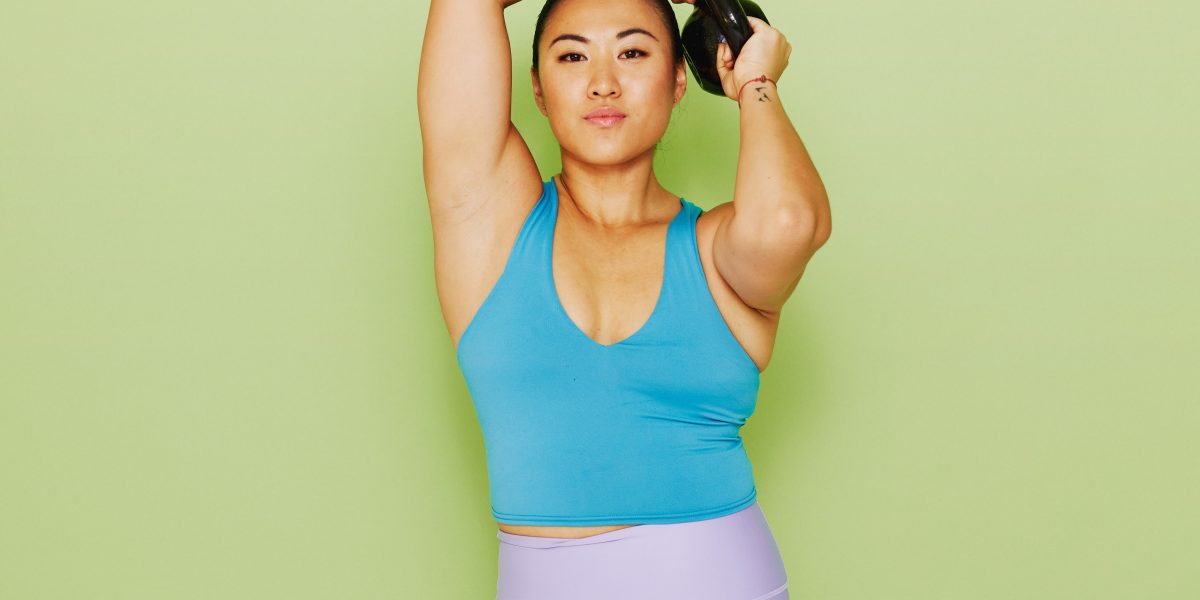If you don’t have a lot of time but still want to pack in the work, a kettlebell shoulder workout that hits every part of this all-important, upper-body muscle group is a must-try.
Kettlebells in general are a great tool for strengthening and stabilizing your shoulders (deltoids), in part because of their design. The asymmetrical weight distribution—one end is heavier than the other—automatically fires up all the small stabilizing muscles in your shoulder, kettlebell specialist Alicia Jamison, MA, CPT, coach at Bodyspace Fitness and lecturer of exercise physiology at Brooklyn College, tells SELF. When you’re holding a kettlebell, these stabilizing muscles turn on to support your shoulder joints as your muscles keep that asymmetrical weight steady as it moves. That level of stabilization doesn’t happen with dumbbells, since those are evenly weighted on both sides, says Jamison.
Strong shoulder stabilizers benefit you both during your workout and outside of it. Strong stabilizing muscles in your shoulders helps create a strong foundation for safely moving weight in pushing and pulling exercises as well as holding a plank position, says Jamison. They also make it easier for you to complete certain tasks in day-to-day life, like carrying groceries—which, like kettlebells, are often an asymmetrical load—pushing a baby stroller, and grabbing something from a high shelf, says Jamison.
Moreover, the asymmetric aspect of kettlebells helps strengthen your shoulders through a greater range of motion compared to dumbbells. Take the overhead press, for instance. In a dumbbell overhead press, you simply press the weights straight up from shoulder level. But in a kettlebell overhead press, proper form involves starting with the weights close together under your chin and then sweeping them out to your sides and up overhead in what looks like a J-shaped curve, says Jamison. This is essential for keeping your shoulders safe in this move: Because the kettlebell weight is asymmetric, you need to hold it close to the midline of your body when beginning and ending the movement to avoid overly straining your shoulders, explains Jamison. Added bonus: The motion also hits your lateral delts, or the side of your shoulders, more than a dumbbell overhead press does.
As for what makes a well-rounded kettlebell shoulder workout? You want to incorporate different types of shoulder exercises to target all three parts of the shoulder: the front, side, and rear delts. You’ll do just that in this five-move kettlebell shoulder workout Jamison created for SELF.
Because this workout is pretty intense on the shoulders, Jamison suggests doing it no more than twice a week. Also important: Do a brief warm-up before you get started so that your muscles and joints are properly primed to work. Jamison suggests doing 10 pull-aparts and 2 to 3 reps of the world’s greatest stretch.
Oh, and when you’re done? Take a few minutes to stretch out your shoulders, says Jamison. She recommends moves like shoulder CARs (a controlled arm circle that takes your shoulder through its full range of motion) and stretches you can do with a TRX or a resistance band and doorframe, like the overhead shoulder stretch and bent-over lat stretch.
The Workout
What you need: Two sets of kettlebells: One set of light weights (about 5 to 10 pounds) for the halo and Turkish get-up. And one medium set (about 10 to 20 pounds) for the snatch, gorilla row, and overhead press.
Exercises
- Kettlebell Snatch
- Gorilla Row
- Double Kettlebell Press
- Kettlebell Halo
- Turkish Get-Up
Directions
- Perform reps of each move for 40 seconds, then rest 20 seconds before moving onto the next move in the circuit.
- For the kettlebell snatch and the Turkish get-up, do the first set with your right arm, the second set with your left arm, and on the third set, switch arms halfway through.
- Repeat the circuit for 3 total rounds. Don’t take any extra rest in between rounds (though of course take a breather if you feel like you can’t catch your breath or your form is slipping).
Demoing the moves below are Amanda Wheeler (GIFs 1, 3, and 5), host of the Covering Ground podcast and Maggi Gao (GIFs 2 and 4), a NASM-certified personal trainer and level-two-certified kettlebell instructor.
